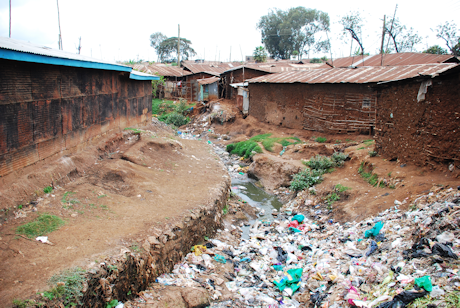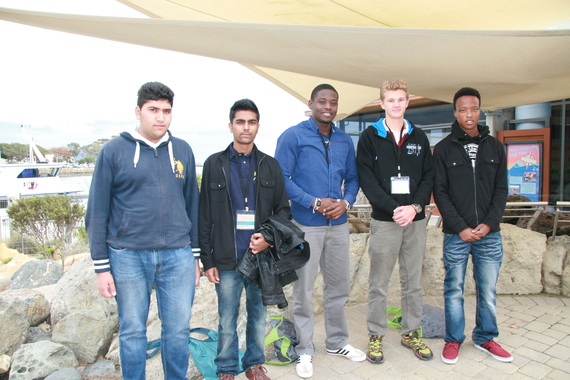Africa's biggest urban slum -- Kibera -- in Kenya's capital Nairobi, has serious public health issues: lack of potable water and the absence of formalized sewage systems are two biggies. But a clever low-tech water filtration project, requiring large numbers of plastic water bottles, could alleviate both problems.
There's no shortage of bottles, according to Nairobi high schooler, Jacob Smith. He says plastic water bottles are everywhere, tossed from car windows by all those wary of Kenya's drinking water -- much of which is high in fluoride. Smith is on the Brookhouse International School's Environment Committee, which amassed a whopping ten thousand water bottles in the past year alone.
These bottles became part of the wastewater recycling at a pilot "town center" in Kibera. The center is the brainchild of the Human Needs Project (HNP), a California based collaborative which developed the plastic water bottle filtration system.
The center is designed to operate as a fully self-contained entity -- providing up to 5,000 Kibera residents a day with the essentials -- water, flushing toilets, showers and laundry services.
Currently most locals buy bad water, which requires boiling. So HNP bored a well, with special filters to ensure water that's not only safe to consume but also has acceptable levels of fluoride. About 19 million Kenyans (42 percent of the population) suffer from fluorosis -- exposure to excess fluoride.
Just as important in the sustainability stakes is recycling the center's wastewater, so as not to exacerbate Kibera's sanitation problems. The slum is known for its ad hoc sewage system - flying toilets -- plastic bags of poo that are flung out of shack windows at night.
This is where all the plastic bottles come in - one hundred and fifty thousand to be exact. That's the number project overseer, Chris Sutton, of Redhorse Constructors, calculated it would take to make all the plavels - mesh onion bags stuffed with cut up recycled plastic water bottles.
The genius of plavels is the high surface area to volume ratio that all the shredded plastic bottles provide. These expanded surfaces mean there's a lot of real estate for pathogen-eating bacteria to set up shop and go to work.
Such bacteria occur naturally in all water and effluent. So the center's waste (grey) water and sewage (black) water gets cleaned by its own microbiotic hitchhikers, without needing a lot of expensive chemical additives.
Plavels are placed throughout a series of filtration tanks, producing water that then flushes the center's 15 toilets. In theory the treated water should be clean enough to drink, but Sutton says the level of monitoring to guarantee potable water is beyond the scope of the project at this stage. Though hopefully the water will soon irrigate crops, and a school football field adjacent to the slum.
When this prototype town center is fully utilized by the locals and financially sustainable - it's owned and operated by a co-op of Kibera residents. HNP hopes to open centers in the 12 other villages that collectively make up the slum. This could mean being able to provide amenities to the 200-300 thousand people estimated to live there.
Such ambitions will take a lot of plastic water bottles, which is where the Brookhouse environment committee comes in. The students are keen to take their plastic water bottle project beyond the collection capabilities of their 750-student school.
In fact, five of them were in California this month after winning a place at Algalita's Plastic Ocean Pollution Solutions (POPS) International Youth Leadership Summit. POPS trains students on how to reduce plastic trash and get the word out about the growing problem of ocean plastic debris.
While Nairobi may be inland, a huge amount of the nine million tons of plastic that's estimated will dump from land into the oceans this year, starts out in places like Kibera with no formalized waste disposal infrastructure. Air and water borne plastic makes it's way to our oceans where is comprises more than 80% of the trash.
Questa Engineering Corporation designed the Kibera plavels, with the goal of reducing Kenya's "plastic bottle menace" and providing essential services. UC Davis scientists tested the concept -- with the permission of Caltrans -- in the wastewater treatment system at Dunnigan rest stop on Highway 5, north of Sacramento.
When the Kenyan high school students presented their plastic bottle collection project at an international summit held in Dana Point, they brought HNP's plavel filtration full circle - from California, to the Kibera slum, and back.
Engineering innovations that address environmental issues and the indignities of poverty are undoubtedly ecological and humanitarian win-wins. What the town center co-op, HNP collaborators, and Brookhouse students illustrate is for such projects to realize their potential, a collective of the willing must take part.



